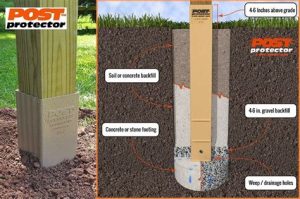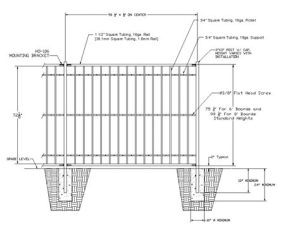Learn essential steps for compliant fence installation, including local regulations, property boundaries, neighbor consultations, design restrictions, and permit application processes.Building a fence can enhance your property’s aesthetic and provide essential privacy and security, but before you start digging, it’s crucial to understand whether you need a permit. Navigating the world of local regulations can be daunting, as rules can vary widely depending on your location, property type, and even homeowner associations. In this blog post, we’ll guide you through the essential steps to determine if a fence permit is necessary for your project. From understanding local regulations and researching property boundaries to consulting with neighbors and your HOA, we’ll cover everything you need to know before taking that first step. Additionally, we’ll discuss height and material restrictions and the process for submitting your permit application. Let’s ensure your fencing project gets off to the right start without any legal hiccups!
Understanding local regulations
When it comes to installing a fence on your property, understanding local regulations is crucial. Different areas have varying laws and regulations related to fencing, which can affect the type, height, and placement of your fence. Most municipalities have specific zoning laws that govern residential fences, and these rules ensure uniformity and safety within neighborhoods.
To avoid violations that could lead to fines or the need to remove your fence, it’s essential to check with your local government or zoning office. They can provide you with information on any necessary permits and help you navigate the code requirements unique to your area. Additionally, some communities may have specific provisions regarding aesthetics, such as color restrictions or materials that can be used.
Do not forget to consult your Homeowners Association (HOA) guidelines if you’re living in a community with an HOA. Many HOAs have their own rules that can be more stringent than local regulations.
Researching your property boundaries
When considering a fence installation, researching your property boundaries is a crucial first step. Before you invest time and money into purchasing a fence, it’s essential to know exactly where your property begins and ends. Incorrect boundary identification can lead to disputes with neighbors or even legal issues.
Start by reviewing the original property survey that outlines your land’s measurements. If you don’t have a copy, you may be able to obtain it from your local government’s land records office. The survey will typically include property lines, easements, and other relevant details that are necessary for accurate understanding.
Additionally, using tools such as online mapping services or property boundary apps can assist you in visualizing your property lines. These services often have layers that show recent property changes, zoning laws, and measurements that can help ensure you stay within your legal boundaries.
Consulting with neighbors and HOA
When considering installing a fence, one important step is consulting with neighbors and the Homeowners Association (HOA). Establishing communication with your neighbors can lead to smoother processes, as they may have insights or concerns regarding the fence. Maintaining good relationships can prevent disputes and misunderstandings later on.
Your HOA likely has its own set of rules and regulations regarding fences. These may include specific guidelines on fence height, material choice, and even design aesthetics. It’s essential to review these regulations carefully to avoid potential fines or the need to remove your fence if it does not comply with their standards.
By having open conversations with your neighbors and checking with the HOA, you can ensure that your fence project aligns with community expectations and legal requirements. This collaborative approach helps to foster a sense of community while ensuring everyone is on the same page.
Determining fence height and material restrictions
When considering the installation of a fence, one of the most crucial aspects to investigate is the height and material restrictions imposed by your local regulations. Different areas have unique zoning laws that dictate what is permissible in terms of these factors.
Before proceeding with your fencing project, take the time to review your local building codes and zoning regulations. These guidelines can determine how tall your fence can be, how you can combine different materials, and what types of fencing are acceptable within your neighborhood. For many jurisdictions, residential fences are often limited to a maximum height of 6 feet in backyards and 4 feet in front yards, but this can vary significantly.
Additionally, some neighborhoods may have specific restrictions that further differentiate between materials based on aesthetic value or durability. For instance, if you live in an HOA (Homeowners Association) governed community, be sure to check their guidelines as they can impose stricter rules than city regulations.
Submitting permit application and fees
Once you have determined that you need a fence permit, the next step is submitting the permit application. This process can seem daunting, but understanding the required steps can make it much easier.
To begin with, you should gather all necessary documentation. This may include your property survey, plans for the fence design, and any other relevant information required by your local building department. It’s essential to check the specific guidelines in your area as these can vary significantly.
Next, you will need to complete the application form and pay any associated fees. These fees can fluctuate based on your location and the type of fence being installed. Some municipalities have online portals for application submission, while others may require you to submit paper forms in person or via mail.
Remember, it’s wise to allow extra time for processing, as this can also differ by location. If your application is incomplete or documentation is missing, it may lead to delays. Therefore, always double-check to ensure that everything is in order before you submit your application.
In addition, consider following up with your local building department if you do not hear back within their usual processing timeframe. This proactive approach can help ensure that your fence permit is approved in a timely manner, allowing you to move forward with your project without unnecessary interruptions.
Frequently Asked Questions
What is a fence permit?
A fence permit is an official approval from a local government or municipality that allows a property owner to construct or modify a fence on their property.
Why might I need a fence permit?
You might need a fence permit to ensure that your fence complies with local zoning laws, building codes, and safety regulations, as well as to avoid potential legal issues with neighbors.
How can I find out if I need a fence permit?
You can check if you need a fence permit by visiting your local government’s website, contacting your town’s zoning office, or consulting with a local contractor familiar with local regulations.
Are there different rules for different types of fences?
Yes, different types of fences, such as privacy fences, chain-link fences, or decorative fences, may have different requirements and regulations, so it’s important to check the specific rules that apply to your intended fence.
What are common reasons why a fence permit might be denied?
Common reasons for permit denial include failing to meet setback requirements, exceeding height restrictions, not adhering to property lines, and lack of necessary documentation.
What documents do I typically need to apply for a fence permit?
Typically, you will need a completed application form, site plans showing the proposed fence’s location, and possibly a drawing of the fence design, among other documentation specific to your locality.
What could happen if I build a fence without a permit?
Building a fence without a permit can result in fines, the requirement to remove the fence, or legal disputes with neighbors, especially if the fence violates zoning regulations.





